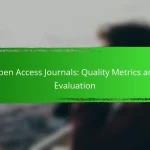The debate between Open Access and subscription-based journals centers on accessibility and credibility in research dissemination. Open Access journals provide unrestricted access to studies, promoting wider readership and engagement, while subscription-based journals offer established credibility and high-quality peer-reviewed content. Choosing the right model depends on factors such as funding availability, audience reach, and the nature of the research topic.

What are the advantages of Open Access journals in the UK?
Open Access journals in the UK offer significant benefits, primarily by allowing unrestricted access to research findings. This model enhances the dissemination of knowledge, making it easier for researchers, practitioners, and the public to access important studies without financial barriers.
Wider accessibility for researchers
Open Access journals provide wider accessibility by removing paywalls that often limit access to subscription-based content. Researchers from various institutions, including those with limited funding, can freely access and utilize research articles, fostering collaboration and innovation.
This model is particularly beneficial for early-career researchers and those in developing regions, as it democratizes access to knowledge that may otherwise be financially out of reach.
Increased visibility and citations
Publishing in Open Access journals typically leads to increased visibility for research work. Studies indicate that articles available freely online tend to receive more views and downloads compared to their subscription-based counterparts.
This increased exposure often translates into higher citation rates, as more researchers can discover and reference the work, enhancing the author’s academic profile and impact within their field.
Faster publication times
Open Access journals generally offer faster publication times compared to traditional subscription-based journals. The streamlined review and publication processes are designed to expedite the dissemination of research findings.
Researchers can often see their work published within a few months, which is crucial in fast-paced fields where timely access to new information is essential for ongoing studies and developments.

What are the advantages of Subscription-Based journals in the UK?
Subscription-based journals in the UK offer several advantages, including established credibility and access to high-quality peer-reviewed research. These journals are often backed by reputable publishers, ensuring that the content is reliable and authoritative.
Established credibility and reputation
Subscription-based journals are typically associated with well-known publishers that have built a strong reputation over time. This credibility can enhance the perceived value of the research published within them, making it more likely to be trusted by academics and professionals.
For researchers, publishing in these journals can be a significant career boost, as it demonstrates adherence to rigorous academic standards. Many institutions and funding bodies recognize and prioritize articles from established journals when evaluating research impact.
Access to peer-reviewed content
One of the key advantages of subscription-based journals is the rigorous peer-review process that articles undergo before publication. This process helps ensure that the research is of high quality, accurate, and contributes meaningfully to the field.
Researchers and practitioners can rely on the integrity of the findings published in these journals, which is crucial when making informed decisions based on the latest evidence. The peer-review process also helps to filter out subpar studies, enhancing the overall quality of the available literature.
Comprehensive archival access
Subscription-based journals often provide comprehensive access to their archives, allowing users to explore a wealth of past research. This can be particularly beneficial for those conducting literature reviews or seeking historical context for their work.
Many journals maintain extensive databases that include articles dating back several years or even decades, offering a rich resource for researchers. This access can be invaluable for understanding the evolution of specific topics and identifying trends in research over time.

When should researchers choose Open Access journals?
Researchers should consider Open Access journals when they want to maximize the visibility and accessibility of their work. This approach is particularly beneficial when funding is available for publication fees, when reaching a broader audience is a priority, or when the research topic has high public interest.
When funding is available for publication fees
Open Access journals often charge publication fees, which can range from a few hundred to several thousand dollars. If researchers have grant funding or institutional support to cover these costs, opting for Open Access can be a strategic choice. This funding can help ensure that the research is freely available to anyone, enhancing its impact.
Before proceeding, researchers should verify that their funding sources allow for Open Access publication fees. Some grants specifically include provisions for these expenses, while others may not, so it’s essential to check the terms of the funding agreement.
For broader audience reach
Choosing Open Access journals can significantly increase the reach of research findings. Unlike subscription-based journals, which may limit access to paying subscribers, Open Access publications allow anyone with internet access to read the work. This can lead to higher citation rates and greater engagement from diverse audiences.
Researchers aiming to influence policy, practice, or public understanding should prioritize Open Access to ensure their findings are widely disseminated. This approach is especially effective in fields where public access to information is crucial, such as health and environmental sciences.
In fields with high public interest
In disciplines like medicine, climate science, and social issues, Open Access can be particularly advantageous. Research in these areas often has implications for public policy or community awareness, making it essential that findings are readily accessible. Open Access journals can facilitate this by removing paywalls that restrict access to critical information.
Researchers should consider the potential impact of their work when selecting a publication venue. If the research addresses urgent societal challenges or public health concerns, Open Access can amplify its relevance and encourage broader discussion and application of the findings.

When should researchers choose Subscription-Based journals?
Researchers should consider subscription-based journals when they need access to high-quality, peer-reviewed articles that may not be available in open access formats. These journals often provide specialized content, established credibility, and access to extensive historical archives.
When seeking specialized content
Subscription-based journals frequently focus on niche topics and advanced research, making them ideal for researchers looking for specialized content. These journals often feature articles from leading experts in their fields, providing in-depth analyses and findings that may not be found elsewhere.
For example, a researcher studying a rare disease might find valuable insights in a subscription journal dedicated to that specific area, whereas broader open access journals may not cover such specialized topics comprehensively.
For established academic credibility
Subscription-based journals typically have rigorous peer-review processes that enhance their academic credibility. Many researchers and institutions regard articles published in these journals as more authoritative due to their established reputation and stringent quality control measures.
Choosing a subscription journal can be particularly important for early-career researchers seeking to build their academic profiles, as publications in reputable journals can significantly impact their career advancement and funding opportunities.
When access to historical archives is important
Subscription-based journals often provide access to extensive historical archives, which can be crucial for researchers conducting longitudinal studies or literature reviews. These archives allow researchers to trace the development of ideas and findings over time, offering context that may be missing in newer, open access publications.
For instance, a historian studying the evolution of a scientific theory may rely on archived articles from subscription journals that span several decades, ensuring a comprehensive understanding of the topic.

What are the costs associated with Open Access and Subscription-Based journals?
The costs for Open Access and Subscription-Based journals vary significantly, impacting authors and institutions differently. Open Access typically involves upfront fees for publishing, while Subscription-Based journals charge ongoing fees for access to their content.
Article processing charges for Open Access
Open Access journals often require authors to pay article processing charges (APCs) to publish their work. These fees can range from a few hundred to several thousand USD, depending on the journal’s reputation and impact factor. Authors should consider their funding sources, as many grants cover these costs.
When selecting an Open Access journal, it’s essential to evaluate the APC in relation to the journal’s visibility and readership. Higher fees may be justified by greater exposure and citation potential.
Subscription fees for journals
Subscription-Based journals charge institutions or individuals for access to their content, with fees varying widely based on the journal’s prestige and the breadth of its offerings. Annual subscription costs can range from a few hundred to several thousand USD, often requiring libraries to allocate significant budgets for access.
Researchers should assess whether their institution has existing subscriptions before attempting to publish in a Subscription-Based journal. This can save costs and ensure access to necessary resources for research and collaboration.
Institutional access costs
Institutions typically pay for access to Subscription-Based journals through licensing agreements, which can be costly. These agreements may cover multiple journals or specific publisher collections, impacting overall budget allocations for libraries and research departments.
When evaluating institutional access, consider the journal’s relevance to your field and the potential return on investment in terms of research output and collaboration opportunities. Institutions may also negotiate with publishers for better rates or bundled access to reduce costs.

How do Open Access and Subscription-Based journals impact research funding?
Open Access and Subscription-Based journals significantly influence research funding by dictating how research outputs are disseminated and accessed. Open Access often aligns with funding agency requirements, while Subscription-Based models may impose additional costs on researchers and institutions.
Open Access aligns with funder mandates
Many funding agencies now require researchers to publish their findings in Open Access formats to ensure wider accessibility and transparency. This alignment helps maximize the impact of research by allowing anyone to access the results without financial barriers.
For example, in the European Union, Horizon 2020 mandates that funded research outputs be made available through Open Access. Researchers should check specific funder guidelines to ensure compliance and avoid potential funding issues.
Subscription-Based journals may limit funding opportunities
Subscription-Based journals can restrict access to research, which may limit the visibility and impact of funded projects. Researchers relying on these journals might miss out on funding opportunities that prioritize Open Access publication.
Additionally, the costs associated with Subscription-Based journals can strain research budgets. Institutions may need to allocate significant portions of their funding to cover subscription fees, which could otherwise be used for research activities.








